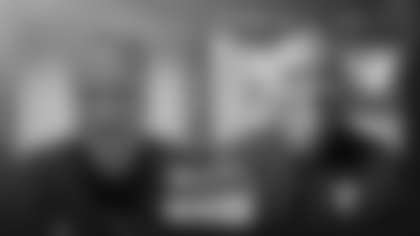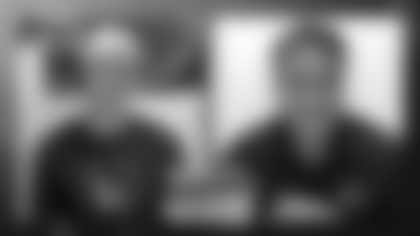Welcome to the latest installment of my weekly "Lunch with Larry," which features wide-ranging conversations with Bears-related guests about their lives and careers.
This week my special guest is former defensive end Alex Brown, who spent his first eight NFL seasons with the Bears from 2002-09 before joining the Saints for one year in 2010. After arriving as a fourth-round draft pick from Florida, Brown appeared in every regular season game in his career beginning with the second contest of his rookie season, a streak of 143 consecutive games. He started all 16 games in six of his eight seasons with the Bears.
Every week I will select the best "Lunch with Larry" fan question, with the winner receiving a Connie's Pizza gift card. The question of the week can be found at the bottom of this article.
Entering the 2002 NFL Draft as Florida's all-time sack leader, Brown expected to be selected late in the first round or early in the second. But when the first day of the draft concluded after three rounds, Brown was still on the board, shocked that he remained a man without a team.
"Going to sleep that night was hard," Brown said. "It was hard. I didn't understand it. I didn't know what I had done wrong."
The next morning, the Bears grabbed Brown with the sixth pick in the fourth round, two spots after his Florida teammate, kicker Jeff Chandler, had been chosen by the 49ers, a team that Brown thought had been interested in him. It was difficult for Brown to fathom a kicker being chosen ahead of him.
"As if [falling into the fourth round] wasn't bad enough, the San Francisco 49ers took my kicker and that hurt," he said. "Any time we played them I really wanted to get after them a little bit."
Brown was a complete defensive end, excelling against both the pass and the run. His 43½ career sacks as a member of the Bears are the fourth most in franchise history and his five interceptions rank second all-time by a Bears defensive lineman, trailing only Hall of Famer Richard Dent, who had eight.
Brown was a natural pass rusher at Florida who learned how to defend the run when he joined the Bears, playing in Dick Jauron's defense that featured beefy linemen such as Ted Washington and Keith Traylor. Brown was asked to add 30 pounds to his 255-pound frame when he arrived in Chicago.
"When I got here, they ran a totally different defense," Brown said. "I was actually stunned that they picked me once I got here and saw what they did. Why would you pick me just to make me gain 30 pounds? That doesn't make any sense."
Brown initially struggled learning how to play in the new defense, so much so that he called his wife, Kari, during his first training camp in Bourbonnais worried that his pro football career would be over before it even started.
Said Brown: "I called my wife and I'm like, 'I don't know if I can do this. Everybody wants to go against this [one offensive lineman] because they can beat him. That guy is whupping my butt. So the guy that everybody wants to go against, he is kicking a hole in my face. I don't know if I can do this. I might need to get a job.' I'm on the phone with her one night I'm supposed to be asleep waiting for the next morning talking to her crying that I can't get this right.
"You need that person sometimes [when] you're going off the track a little bit. She was that person that could get me back to focus on what I needed to be focused on and keep that confidence in myself because [if] I never thought like that in college, why am I thinking like that now?"
Brown adjusted and made an impact as a rookie. After his second season, Jauron was replaced as coach by Lovie Smith, who immediately asked Brown to lose the 30 pounds he had gained two years earlier and return to his college playing weight.
Brown thrived under Smith, playing on a defense that also featured Brian Urlacher, Mike Brown, Charles Tillman, Lance Briggs and Tommie Harris, among others. The unit led the Bears to back-to-back NFC North championships in 2005-06 and an appearance in Super Bowl XLI to cap the 2006 season.
Smith's defense was known for its ability to generate takeaways—and return them for touchdowns. It was a mentality he implemented immediately, having defensive players run, run and run some more in practice.
"At that time, it was like nonsense," Brown said. "It was like, 'Are you kidding me, it's an incomplete pass, why am I picking it up acting like it's a fumble? Like, what are you talking about?' And he just harped on it and harped on it, and after a while, it becomes the mentality. It's just what we do.
"And once you got your body in shape to run constantly, all day long, that defense just took off. That talent was here. It was more or less just molding that talent and getting it to where he wanted it … It didn't take long, but it was definitely hard, hard work."
There were many dominant performances, but a signature game for the defense came on a magical Monday night in Arizona in 2006. The Bears turned a 23-3 third-quarter deficit into a thrilling 24-23 victory over the Cardinals without scoring an offensive touchdown.
Rookie defensive end Mark Anderson ignited the comeback, forcing rookie quarterback Matt Leinart to fumble on a blindside sack. Mike Brown scooped up the loose ball and returned it 3 yards for a TD, drawing the Bears to within 23-10 with :02 remaining in the third quarter.
The defense delivered again as Urlacher ripped the ball away from running back Edgerrin James and Tillman returned the fumble 40 yards for a TD, closing the gap to 23-17 with 5:00 left in the final period.
Rookie Devin Hester then produced one of the most memorable plays of his Hall of Fame career, returning a punt 83 yards for a TD to put the Bears ahead 24-23 with 2:58 to play.
Asked what stood out most about the win, Brown said: "Hester returning it. We figured as a defense if we gave him a chance that he'd take it back and they kicked it to him. I was like, 'no way they're going to kick it to him,' and they did, and he promptly took it to the house."
After Hester's TD, the Cardinals marched to the Bears' 22, but Neil Rackers missed a 40-yard field goal attempt wide left with :47 remaining.
"We didn't play great at all," Brown said. "Even though the defense scored and did all that stuff … at the end of the game, we needed to go get a three-and-out and we couldn't do it. They had to miss a field goal at the end … It was a nail-biter all the way until the end. We were exhausted, that's for sure."
Here's the "Lunch with Larry" fan question of the week, submitted by Marty W.: I know Alex was a quarterback in high school. Is that why he wore No. 13 at Florida?
Brown was in fact a star quarterback at Hamilton County High School in Jasper, Fla., while also doubling as a linebacker. But he wore No. 13 at Florida to honor a cousin he grew up with, McArthur Zanders Jr., who passed away in a car accident when Brown was 15 years old. Here's what Alex said about honoring his late cousin by wearing his number: "It's the one thing I take more pride in than actually playing football because it was almost like a promise to him because we really thought one of us would make it to the NFL, and he never got that opportunity. I tried to never take it for granted because he would have given everything to be in my shoes."
In closing, I'd like to thank Alex for discussing his life and career with me. I covered him as a player and am fortunate to have remained friends with him over the years. He was a great defensive end and is an excellent person!














